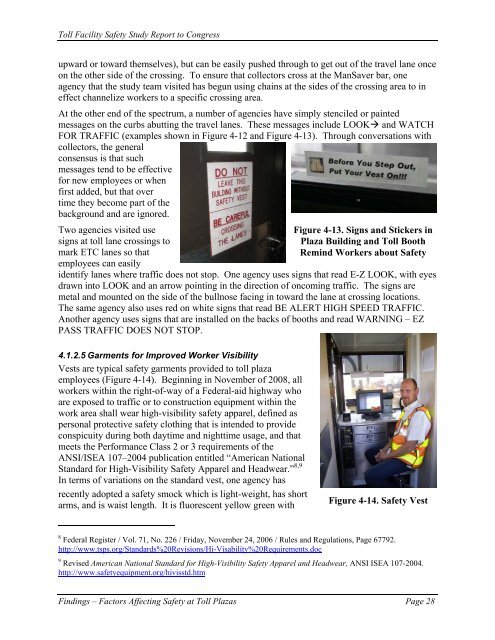Toll Facility Safety Study Report to Congress - About
Toll Facility Safety Study Report to Congress - About
Toll Facility Safety Study Report to Congress - About
You also want an ePaper? Increase the reach of your titles
YUMPU automatically turns print PDFs into web optimized ePapers that Google loves.
<strong>Toll</strong> <strong>Facility</strong> <strong>Safety</strong> <strong>Study</strong> <strong>Report</strong> <strong>to</strong> <strong>Congress</strong><br />
upward or <strong>to</strong>ward themselves), but can be easily pushed through <strong>to</strong> get out of the travel lane once<br />
on the other side of the crossing. To ensure that collec<strong>to</strong>rs cross at the ManSaver bar, one<br />
agency that the study team visited has begun using chains at the sides of the crossing area <strong>to</strong> in<br />
effect channelize workers <strong>to</strong> a specific crossing area.<br />
At the other end of the spectrum, a number of agencies have simply stenciled or painted<br />
messages on the curbs abutting the travel lanes. These messages include LOOK and WATCH<br />
FOR TRAFFIC (examples shown in Figure 4-12 and Figure 4-13). Through conversations with<br />
collec<strong>to</strong>rs, the general<br />
consensus is that such<br />
messages tend <strong>to</strong> be effective<br />
for new employees or when<br />
first added, but that over<br />
time they become part of the<br />
background and are ignored.<br />
Two agencies visited use<br />
signs at <strong>to</strong>ll lane crossings <strong>to</strong><br />
mark ETC lanes so that<br />
employees can easily<br />
identify lanes where traffic does not s<strong>to</strong>p. One agency uses signs that read E-Z LOOK, with eyes<br />
drawn in<strong>to</strong> LOOK and an arrow pointing in the direction of oncoming traffic. The signs are<br />
metal and mounted on the side of the bullnose facing in <strong>to</strong>ward the lane at crossing locations.<br />
The same agency also uses red on white signs that read BE ALERT HIGH SPEED TRAFFIC.<br />
Another agency uses signs that are installed on the backs of booths and read WARNING – EZ<br />
PASS TRAFFIC DOES NOT STOP.<br />
4.1.2.5 Garments for Improved Worker Visibility<br />
Vests are typical safety garments provided <strong>to</strong> <strong>to</strong>ll plaza<br />
employees (Figure 4-14). Beginning in November of 2008, all<br />
workers within the right-of-way of a Federal-aid highway who<br />
are exposed <strong>to</strong> traffic or <strong>to</strong> construction equipment within the<br />
work area shall wear high-visibility safety apparel, defined as<br />
personal protective safety clothing that is intended <strong>to</strong> provide<br />
conspicuity during both daytime and nighttime usage, and that<br />
meets the Performance Class 2 or 3 requirements of the<br />
ANSI/ISEA 107–2004 publication entitled “American National<br />
Standard for High-Visibility <strong>Safety</strong> Apparel and Headwear.” 8,9<br />
In terms of variations on the standard vest, one agency has<br />
recently adopted a safety smock which is light-weight, has short<br />
arms, and is waist length. It is fluorescent yellow green with<br />
Figure 4-13. Signs and Stickers in<br />
Plaza Building and <strong>Toll</strong> Booth<br />
Remind Workers about <strong>Safety</strong><br />
Figure 4-14. <strong>Safety</strong> Vest<br />
8 Federal Register / Vol. 71, No. 226 / Friday, November 24, 2006 / Rules and Regulations, Page 67792.<br />
http://www.tsps.org/Standards%20Revisions/Hi-Visability%20Requirements.doc<br />
9<br />
Revised American National Standard for High-Visibility <strong>Safety</strong> Apparel and Headwear, ANSI ISEA 107-2004.<br />
http://www.safetyequipment.org/hivisstd.htm<br />
Findings – Fac<strong>to</strong>rs Affecting <strong>Safety</strong> at <strong>Toll</strong> Plazas Page 28

















